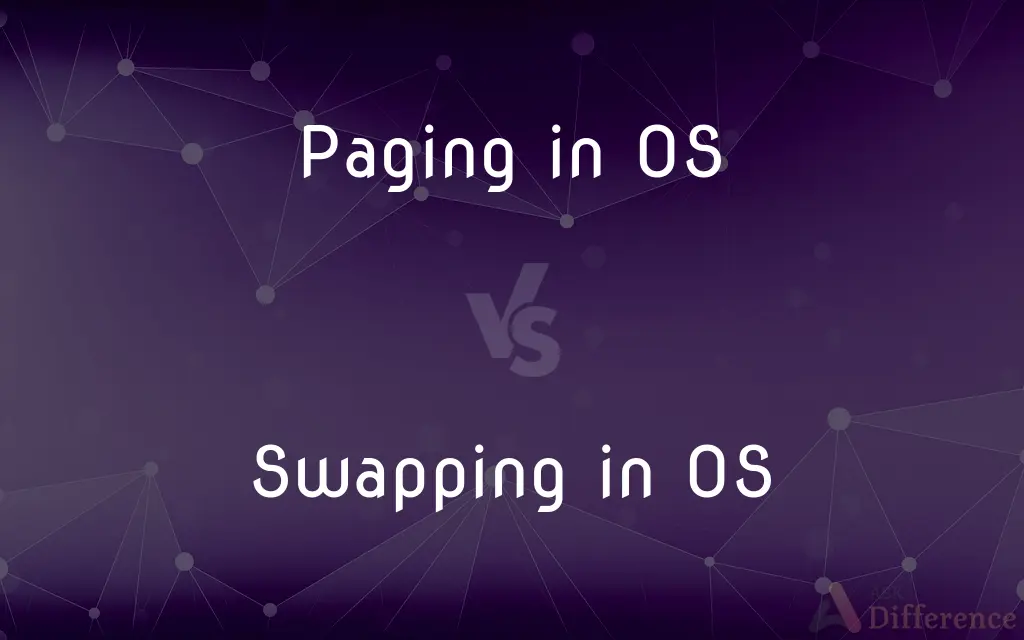Paging in OS vs. Swapping in OS — What's the Difference?
By Tayyaba Rehman & Urooj Arif — Published on February 5, 2024
Paging in OS divides memory into fixed-size blocks for efficient allocation, whereas swapping in OS moves entire processes in and out of memory to manage space.

Difference Between Paging in OS and Swapping in OS
Table of Contents
ADVERTISEMENT
Key Differences
Paging in OS involves dividing the computer's memory into small, fixed-sized blocks called pages. It's a memory management scheme that allows the physical address space of a process to be noncontiguous, making efficient use of memory and reducing fragmentation. Swapping in OS, on the other hand, is a process management technique. It moves entire processes from main memory to a secondary storage (like a hard disk or SSD) and back to memory. This is usually done to free up memory for other processes when the system is running low on RAM.
In Paging, the operating system maintains a page table to keep track of where pages are stored in physical memory. This helps in translating logical addresses to physical addresses during program execution. Swapping, conversely, is concerned with managing the space in the main memory. When a process is swapped out, its entire state is saved onto the disk, and when it's swapped back in, it resumes execution from where it left off.
Paging is generally more frequent and involves less data transfer compared to swapping. Since only portions of a process's memory are moved (the pages), it's more efficient and happens transparently to the user. Swapping involves moving entire processes, which can be a time-consuming operation, especially if the disk is slow. This can lead to significant performance degradation if it happens frequently.
Another aspect of paging is that it allows for memory overcommitment, where the total virtual memory allocated to processes can exceed the actual physical memory. This is made possible by the use of a paging file or swap space. On the other hand, swapping is a more drastic measure, usually invoked when the system is under heavy memory pressure or when a process has been idle for a long time.
Paging is a fundamental part of modern operating systems and is always active. It's essential for efficient memory usage and multitasking. Swapping, while also important, is more of a backup strategy for memory management. It's used only when necessary, as frequent swapping can severely affect system performance.
ADVERTISEMENT
Comparison Chart
Memory Unit
Deals with pages (small, fixed size)
Deals with entire processes
Frequency
More frequent, less data per operation
Less frequent, more data per operation
Performance Impact
Generally minimal
Can be significant if frequent
Primary Purpose
Efficient memory allocation
Managing memory pressure
Overhead
Lower, due to smaller data transfers
Higher, due to complete process swap
Compare with Definitions
Paging in OS
Paging allows non-contiguous memory allocation to avoid fragmentation.
Paging in OS simplifies memory management by breaking it into manageable parts.
Swapping in OS
Swapping is less frequent than paging but involves larger data sets.
Unlike paging, swapping is not a constant process but occurs in response to specific memory conditions.
Paging in OS
Paging provides a mechanism for virtual memory management.
Paging allows the OS to use disk space as an extension of RAM.
Swapping in OS
Swapping is a backup strategy for memory management in OS.
The OS resorts to swapping when paging alone cannot handle the memory demands.
Paging in OS
Paging can lead to memory overcommitment, allowing more memory to be allocated than physically available.
Through paging, the OS can allocate more memory to programs than the physical memory in the system.
Swapping in OS
Swapping involves significant data transfer, affecting system performance.
Heavy swapping can slow down the system due to frequent disk reads and writes.
Paging in OS
Paging involves a translation layer between logical and physical memory addresses.
The OS uses paging to translate the program's view of memory to actual memory addresses.
Swapping in OS
Swapping is used to handle memory shortages and manage multitasking.
When RAM is full, the OS swaps out less-used processes to maintain system performance.
Paging in OS
Paging is the process of managing program memory in fixed-size chunks.
In paging, the OS efficiently handles memory without the program knowing the physical location of its data.
Swapping in OS
Swapping is moving entire processes between main memory and secondary storage.
The OS uses swapping to free up RAM for new processes by moving inactive ones to the disk.
Common Curiosities
When is Swapping used in an OS?
Swapping is used when there's insufficient RAM, requiring some processes to be moved to disk temporarily.
Does Paging affect system performance?
Generally, paging has minimal impact on performance due to handling small data chunks.
What is Swapping in OS?
Swapping involves moving entire processes between main memory and secondary storage to manage memory.
How does Swapping differ from Paging?
Swapping moves entire processes, while paging deals with smaller, fixed-size memory blocks.
What is Paging in OS?
Paging is a memory management scheme that divides memory into fixed-size blocks called pages.
How does Paging improve memory management?
Paging allows non-contiguous memory allocation, reducing fragmentation and making efficient use of RAM.
What's the role of a page table in Paging?
The page table maps logical addresses to physical addresses, enabling the OS to manage memory efficiently.
Is Paging always active in modern OS?
Yes, paging is a fundamental part of modern operating systems and is always active.
Can Paging lead to memory overcommitment?
Yes, paging can lead to memory overcommitment by allocating more virtual memory than the physical RAM.
Is Swapping bad for system performance?
Frequent swapping can degrade performance due to the time-consuming disk read/write operations.
Is Paging or Swapping more efficient?
Paging is generally more efficient due to its smaller and more frequent operations compared to swapping.
What happens when a process is swapped out?
When swapped out, the process's state is saved to disk, freeing up RAM for other processes.
Can Swapping be avoided in an OS?
Swapping can be minimized with sufficient RAM and efficient memory management but not completely avoided.
What causes page faults in Paging?
Page faults occur when a program accesses a page that is not currently in physical memory.
How does Swapping help in multitasking?
Swapping allows multiple processes to run by temporarily moving inactive ones to disk, freeing up RAM.
Share Your Discovery

Previous Comparison
Canada vs. United States
Next Comparison
B.E. vs. M.C.A.Author Spotlight
Written by
Tayyaba RehmanTayyaba Rehman is a distinguished writer, currently serving as a primary contributor to askdifference.com. As a researcher in semantics and etymology, Tayyaba's passion for the complexity of languages and their distinctions has found a perfect home on the platform. Tayyaba delves into the intricacies of language, distinguishing between commonly confused words and phrases, thereby providing clarity for readers worldwide.
Co-written by
Urooj ArifUrooj is a skilled content writer at Ask Difference, known for her exceptional ability to simplify complex topics into engaging and informative content. With a passion for research and a flair for clear, concise writing, she consistently delivers articles that resonate with our diverse audience.
















































